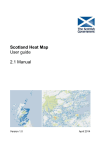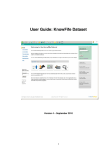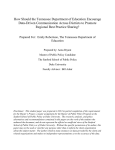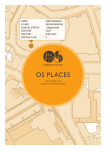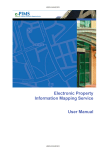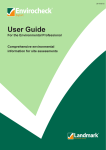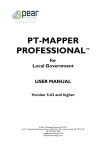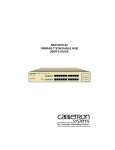Download Scotland Heat Map User Guide 2.2 Metadata, limitations and data
Transcript
Scotland Heat Map User Guide Metadata for heat map datasets, limitations and protections for data use and analysis, and data management for the Scotland heat map data 2.2 Metadata, limitations and data management Version 1.0 April 2014 Heat, Energy Efficiency and Low Carbon Investment Energy & Climate Change Directorate Scottish Government Victoria Quay Area 1 D South EDINBURGH EH6 6QQ e-mail: web: [email protected] www.scotland.gov.uk/heatmap This is published electronically to limit the use of paper, but photocopies will be provided on request to Heat, Energy Efficiency and Low Carbon Investment. This document provides a guide to the data, its use and management in three sections: Metadata Limitations and protections for use and analysis Data management 1. Metadata The Scotland heat map holds data covering the following area: OS Mastermap and Addressbase [OSMA members] Heat demand Assessor and EPC Data Actual Energy Demand (Public Sector) Heat Demand Layer (combined) Tenure Energy Supply Layer District Heating Networks Planning and Economic Development Opportunities and constraints Layer options Additional layers Utilities Layout The Scottish Government has provided metadata for the four derived data layers: Heat Demand Energy Supply Heat Networks Tenure Attributes are provided for the four derived data layers. Metadata is provided in Scotland heat map – User Guide 2.2i Metadata. 2. Limitations and protections for use and analysis The guide outlines the Limitations and protections for data use and analysis for Scotland heat map data as outlined in the Scotland heat map - Framework Agreement 1.0, and in particular Section 7- Specific limitations on data use. Scotland heat map - User Guide - 2.3 Metadata outlines all the data used to create each layer of the Scotland heat map public sector dataset. Different data comes with different limitations to use. There are a number of different types of data used to create the Scotland heat map: Data provided through agreement Data provided through online resources or from other organisations Derived data, which has been transformed or manipulated for use in the Scotland heat map. The Scottish Government is the data owner for derived data. The Scotland heat map is provided in a number of separate layers. Different data sets are draw together, or held, in these separate layers. Using the Scotland heat map binds you to the data restrictions for all the data used in creating the data layers. All analyst staff approved to access the data are cleared at Baseline Personnel Security Standard (BPSS) or similar and have received protecting information training. 2.1 Data review While participants using the Scotland heat map data are under a duty to comply with all relevant obligations under the Data Protection Act 1998 (“the DPA”), the Scotland heat map is considered to be non-personal within the meaning of section 1 of the DPA as outlined in Section 2 of the Scotland heat map Framework Agreement 1.0. This duty also compliments any ethical duty participants might have under the general principles of their organisation or professional body on the use of data. The Scottish Government has reviewed the Scotland heat map dataset with the aim of making as small as possible the risk releasing confidential information whilst maximising the access to useful, high quality data. Because of this personal data has not been included in the Scotland heat map dataset. To test out possible scenarios the Scottish Government has used Statistical Disclosure Control to review this risk. In our review of statistical disclosure control we sought to assess the risk of disclosing information unintentionally through making the heat map data available to users. This involved testing the data to see if any attributes could be attributed to individuals, households or businesses in a way that would allow a user to learn more data about one of these units than is already available from public sources. The approach taken gave consideration to; the data environment that data are to be released into i.e. what data are publicly available that share similar attributes; the sensitivity of the data’s attributes i.e. what attributes should be considered in need of specific protection; and the relative uniqueness of records and the potential for attribution to identifiable people or businesses. The latter are tested using scenarios that encompass attempts to match the data to publicly available sources such as the electoral register. The review concluded the data could not, with any degree of certainty, be attributed to individuals, households or businesses. The level of geography at different layers in the heat map also provides a degree of ambiguity in the attribution of attributes to individual buildings. This supports the conclusion above that the statistical disclosure risk is very low. As the data environment changes over time this review process will be repeated and relevant documentation updated. 2.2 Data layers 2.3 Heat demand Provides potential demand sources for modelling opportunities for heat, energy reduction and linking to supply opportunities. The heat demand layer must be aggregated before it is released to third parties. The modeled kWh heat demand data can only be released at or above a 50 meter grid. Other data can only be released under the terms of each dataset detailed in 2.5 Underlying data. 2.4 Heat supply Provides potential supply sources for modelling opportunities for heat networks or energy reduction and supply opportunities. The heat demand layer must be aggregated before it is released to third parties. Data can only be released under the terms of each dataset detailed in 2.5 Underlying data. 2.5 Underlying data 2.5.1 Area data Local authority, postcode and settlement boundaries are available from the General Register Office for Scotland on Open Government Licence. Datazone and intermediate datazone are available from Scottish Neighbourhood Statistics on Open Government Licence. 2.5.2 Cooling towers Cooling tower data was provided by local authorities under Freedom Of Information. These have been used for the heat supply layers. 2.5.3 Distilleries Distillery data is property of the Scotch Whisky Association and includes site of distilleries and volumetric production. This has been used for heat demand and heat supply layers. 2.5.4 District heating network The district heating network data within the Scotland heat map has been reviewed and classified by the Scottish Government as non-personal data. It provides potential and actual district heat networks for connection and expansion and supply modelling opportunities. Shapefile data of the networks has been provided by the network owners. Network data is the property of the network owners and cannot be given to third parties without the owner’s consent. It can be used for research and statistical purposes. Point data of the networks data is managed by the Scottish public sector organisations within the Heat Network Partnership. Network data the property of the network owners and cannot be given to third parties without the owner’s consent. Network owners will be approached during 2014-15 to seek agreement for their data to be publically available. Until that time district heat network data is restricted to named individuals and can only be used for heat research and statistical purposes. In addition, only publicly owned network point data can be shown. 2.5.5 Energy from Waste Waste Resources Action Programme (WRAP) maintains a list of energy from waste sites. This material has been reproduced from the website www.wrap.org.uk of The Waste and Resources Action Programme. 2.5.6 Energy Performance Certificates Energy performance Certificate data is part of the heat demand layer. Local authorities are the enforcement bodies for The Energy Performance of Buildings (Scotland) Regulations 2008 [last amended 2013] and have access to register data. Use of data is restricted to statistical and research purposes only with named individuals. Research includes the feasibility of different heat and energy efficiency solutions. 2.5.7 Geothermal Coal mine data on positions, depth and scale, mine abandonment plans, mine entries, and pumped water are all held by the Coal authority. Use of Coal Authority data within the heat map is restricted to statistical and research purposes only with named individuals. Research includes the feasibility of different heat and energy efficiency solutions. British Geological Survey provided data on geothermal resource. Use of data within the heat map is restricted to statistical and research purposes only with named individuals. Research includes the feasibility of different heat and energy efficiency solutions. These have been used for the heat supply layers. Borehole temperatures, opportunities from coal mines, sedimentary hot aquifers and hot granites are available through Study into the Potential for Deep Geothermal Energy in Scotland: Volume 2. 2.5.8 Office of gas and electricity markets (Ofgem) Ofgem collates statistical analysis or research and development on the Renewables Obligation RO, Feed-in-Tariff (FIT) scheme and Renewable Energy Guarantees of Origin (REGO). Data is provided through Ofgem Eserve including limitations of use. 2.5.9 Opportunities and constraints The Scottish Index of Multiple Deprivation (SIMD) is the Scottish Government's official tool for identifying those places in Scotland suffering from deprivation and is available on Open Government Licence. Conservation sites can be downloaded from Scottish Natural Heritage and is available using a Scottish Government Licence. Historic Properties In Care, Listed Buildings, Scheduled Monuments and Battlefields can be downloaded from Historic Scotland and are available through agreement. 2.5.10 Ordnance Survey AddressBase product Use of the Scotland heat map requires the user to be part of the One Scotland Mapping Agreement. In future it is planned that this will also contain an additional opportunities constraints layer: the water networks water layer. 2.5.11 Planning Local Development Plan, Housing Land Audits and planning permission and building certificates have been provided by some Scottish Local Authorities. These datasets are the property of the Local Authorities. They are for research and statistical purposes and is restricted to named users and cannot be provided to a third party cannot be given to third parties without the owner’s consent. 2.5.12 Public and other organisations energy data All public sector organisations who control their building energy have provided building energy use for the heat demand layer. Information has also been provided by other organisations, such as universities and colleges. Organisations have also provided energy supply data. Each providing body is the data owner. Data has also been provided as part of the Public Sector Procurement for electricity and natural gas. Use of underlying Public Sector Procurement data is for research and statistical purposes and is restricted to named users and cannot be provided to a third party. The Government’s electronic Property Information and Mapping Service (ePIMS) is the central database of Government Central Civil Estate properties and land. Non-personal ePIMS data was used within the heat demand layer. Use of underlying ePIMS data is for research and statistical purposes and is restricted to named users and cannot be provided to a third party. 2.5.13 Renewable energy The Energy Saving Trust Scotland and Forestry Commission Scotland collate data on Renewable Heat generation for the Scottish Government. Use of data is restricted to statistical and research purposes only with named individuals. Research includes the feasibility of different heat and energy efficiency solutions. These have been used for the heat supply layers. Wind energy sites can be downloaded from Scottish Natural Heritage and is available using a Scottish Government Licence. The Department of Energy and Climate Change (DECC) collate Renewable Energy STATisticS database (Restats). This contains performance statistics on all relevant renewable energy sources in the United Kingdom. Guidance for use is provided. These have been used for the heat supply layers. 2.5.14 Scottish Assessor Assessor data provides knowledge of building characteristics necessary for modeling heat demand and broader energy use in Scottish buildings. Scottish Assessors have entered into a data sharing agreement that allows the Scottish Government and Local Authorities to use the Scottish Assessor Data in the Scotland heat map. The 14 Scottish Assessors are open to consider use by other public sector organisations. The Assessors have asked to be approached individually by the public sector organisations who want to use their data embedded in the Scotland heat map. The areas covered by each Scottish Assessor and their contact details are provided through the Scottish Assessor Association. The Scottish Government can provide the template agreement it uses to support this process ([email protected]). 2.5.15 Scottish Environmental Protection Agency (SEPA) The Scottish Pollutant Release Inventory (SPRI), Combined Heat and Power (CHP) generation and Energy from Waste data and heat plans are used for the heat supply layer. SEPA data has limitations for use. Limitations include, but are not limited to, data must not be sold on or used for any commercial activity without agreement of SEPA (www.sepa.org.uk). 2.5.16 Scottish Water Scottish Water Horizons holds data on Waste Water Treatment Works and Anaerobic Digestion. Use of data is restricted to statistical and research purposes only with named individuals. Research includes the feasibility of different heat and energy efficiency solutions. These have been used for the heat supply layers. 2.5.17 Tenure Tenure data within the Scotland heat map has been reviewed and classified by the Scottish Government as non-personal data. This provides necessary information for modelling opportunity for heat networks or energy reduction and supply opportunities. Datazone tenure data from the Census 2011 and is available on Open Government Licence. Tenure data by datazone has been used in the heat map. Individual building tenure data is has been provided by local authorities and the Scottish Federation of Housing Associations. Tenure data provided in the Scotland heat map cannot be used for unsolicited marketing as outlined by the Information Commissioners Office. 2.5.18 Utility Local Authorities can approach Scotia Gas Networks for high and medium pressure gas pipe shapefiles. This require a separate Agreement for the provision of maps data in GIS format. High pressure gas pipe shapefiles for Scotland are available from the National Grid. Terms and conditions apply. 3. Data management It is recommended that there is a single lead for coordinating data management and collection for each participating organisation. You may also wish to identify data controllers for each data source. Key areas often include: GIS Planning Energy and Asset Management Housing Economic Development Where data is changed, such as correction or adding new data, then this should be part of the Scotland heat map – User guide 2.3 Validation & improvement. 3.1 Data provision for the Scotland heat map Data provision is included in the Scotland heat map – user guide 2.1 manual for local authorities. 3.1.1 Building energy management and asset data Building energy demand (Attributes of building and energy use, including Unique Property Reference Number) To provide a secure, efficient and effective electronic data exchange, the Scottish Government has amended a web based data collection and validation tool it hosts called ProcXed. The tool is designed to allow collection and validation of any combination of site, building, heating and cooling data. This data can be uploaded by template, via xml, or input directly to a web form. The ProcXed energy management tool is being tested and we expect will be publically available in late June 2014. A further guide on using ProcXed will be made available to data managers. Please provide contact details using the Scotland heat map – Framework Agreement 1.2 Data users form or email [email protected] for further information. 3.1.2 Planning Local Development Plan (GIS Shapefiles with linked attributes) Housing Land Audits (GIS Shapefiles with linked attributes including annual build rates) Planning permission (Attributes of planning permission, building including Unique Property Reference Number) Building Certificate (Attributes of building certificate, building including Unique Property Reference Number) 3.1.3 Tenure Building tenures (Attributes of tenure and address, including Unique Property Reference Number) Socially rented owned by the data provider (Attributes of building, energy sources and energy efficiency measures, including Unique Property Reference Number) 3.1.4 Cooling towers Environmental Health cooling tower records (Attributes of address) 3.1.5 Heat supply opportunities Energy supply plant (Attributes of plant, address including building, energy supplied and potential spare capacity, including Unique Property Reference Number where applicable) 3.1.6 District heat networks Energy supply plant (Attributes of plant, address including building, energy supplied and potential spare capacity, including Unique Property Reference Number where applicable) Pipe network (best format shown first: GIS shapefiles, CAD file, or pdf). An suggested specification is found in Scotland heat map - User Guide - 2.2 Metadata, limitations and data management Buildings connected to the network (Attributes of building and energy use, including Unique Property Reference Number) Recording accurately where heat networks are helps ongoing management and future expansion. Recorded in the right way this data can easily be placed in a GIS map format. A heat network specification has been developed to include in contracts for feasibility studies through to heat network development to encourage more accurate recording of heat networks that can be used in the Scotland heatmap.













